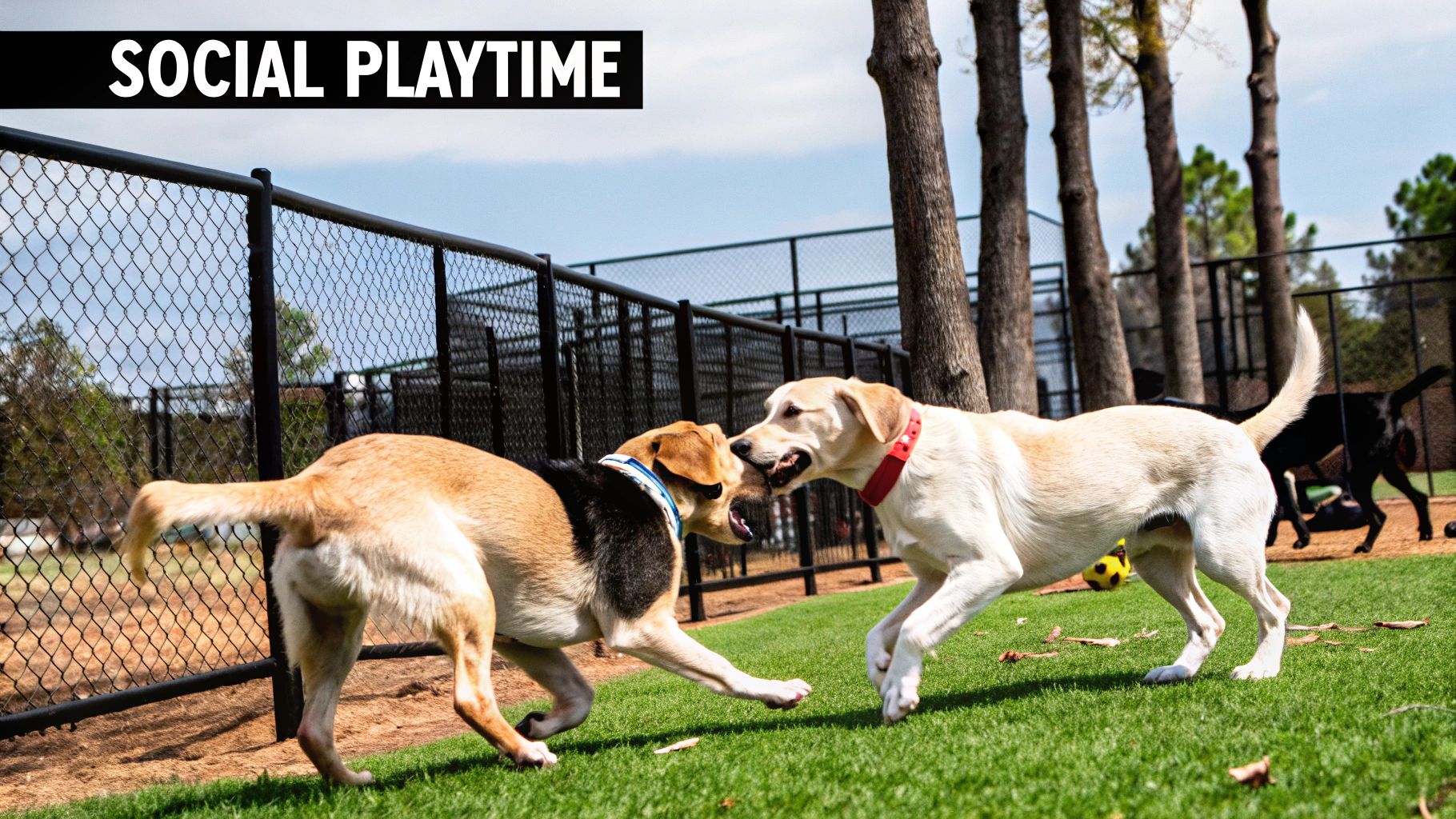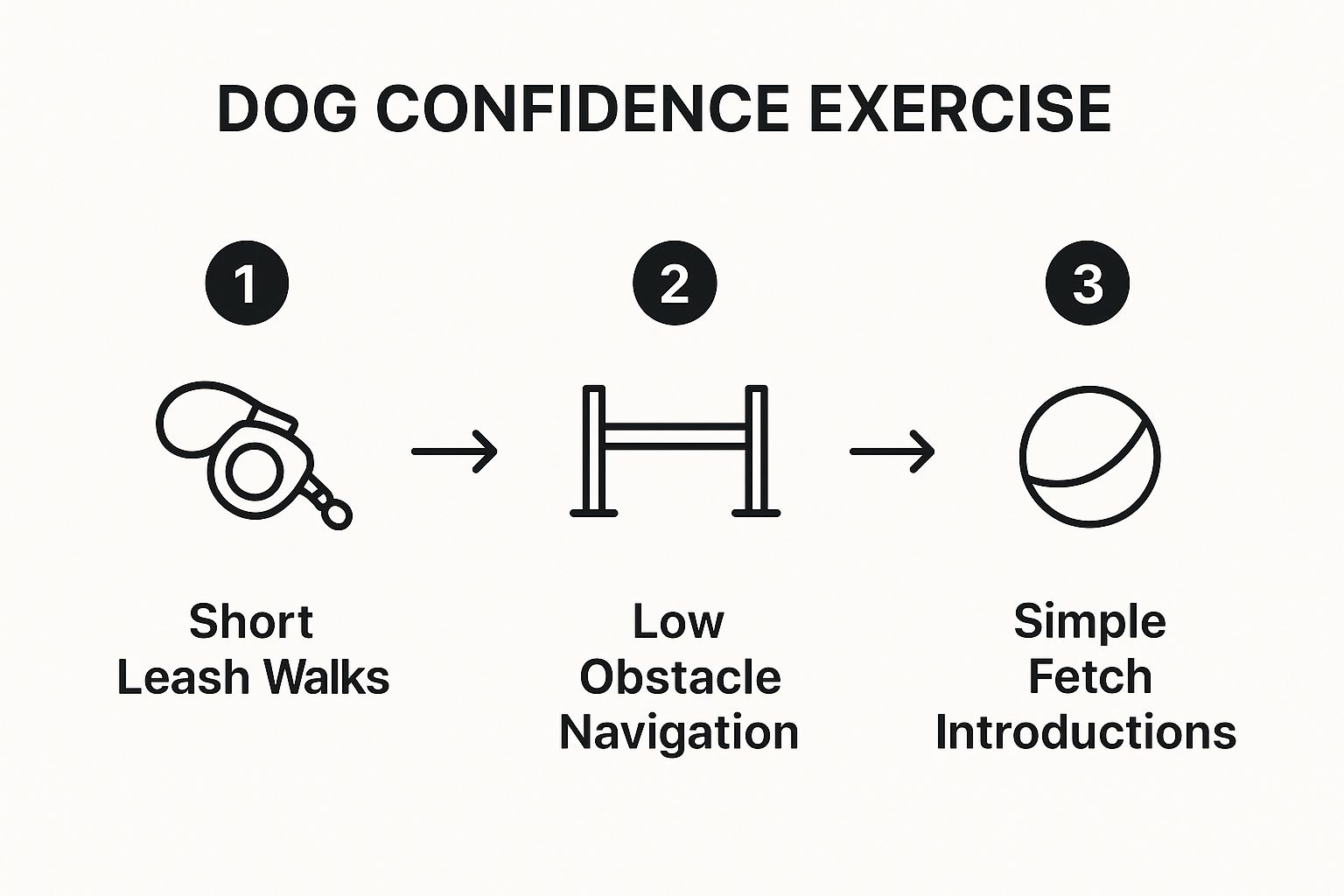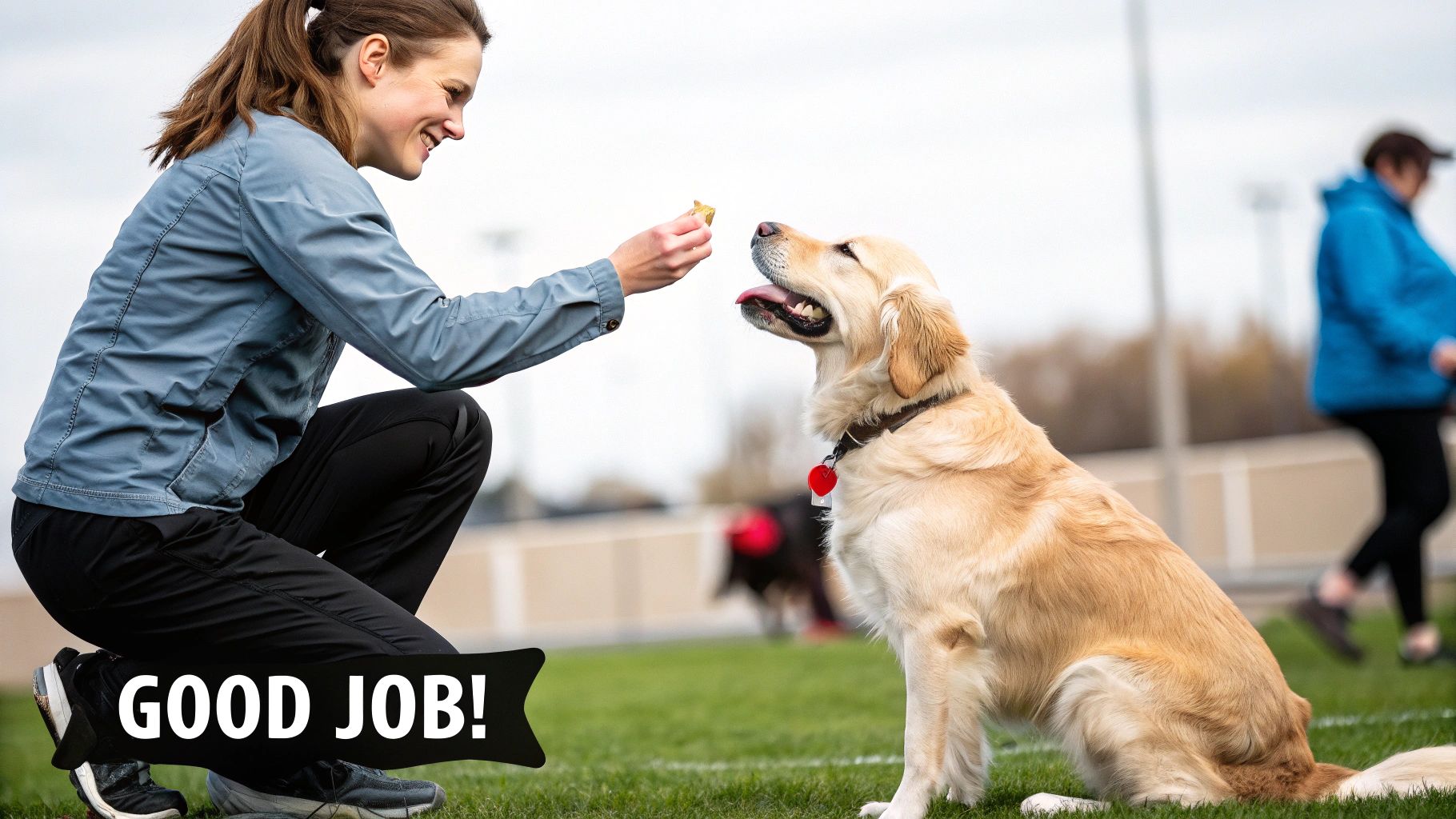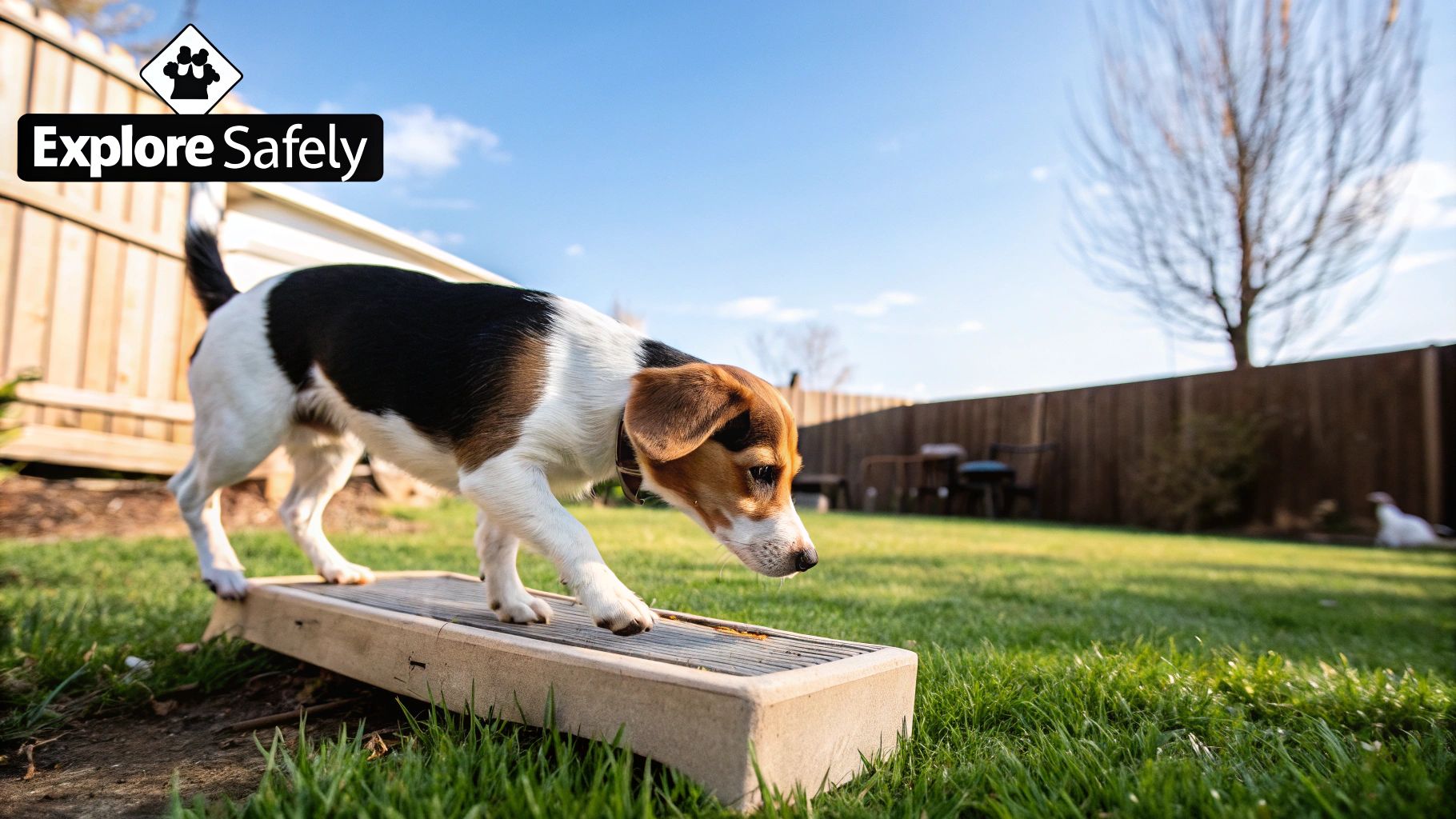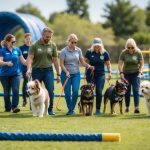It’s heartbreaking to watch a dog you love struggle with the world. You see the hesitation in their step, the worry in their eyes, and you just want to make it all better. We completely understand. This isn't just about 'fixing' a behaviour; it's about giving your best friend the security they need to truly enjoy life with you.
Building a dog’s confidence is a journey, and it starts right here, with us working together. It’s about patience, understanding, and celebrating the tiny victories along the way.
Your Journey to a More Confident Dog
Let's be clear: there are no magic wands or overnight cures. Real confidence is built on a foundation of trust, and that takes time. Our goal here is to help you forge a deep, unshakable bond with your dog. A confident dog isn't always the loudest or most boisterous one in the park. It’s a dog that feels safe in its own skin and trusts you, its guardian, to have its back.
Why Confidence Is So Important
A lack of confidence is often the hidden cause behind many common behavioural issues. When a dog feels insecure, their fear can manifest in ways we might mistake for stubbornness or even aggression. Helping them build genuine self-assurance pays off in so many ways, far beyond just having a "well-behaved" dog.
- Improved Well-being: A confident dog carries less chronic stress, which is a massive boost for their long-term physical and mental health.
- A Stronger Bond: Working together to build confidence creates an incredible partnership. It’s a team effort built on two-way communication and trust.
- Greater Resilience: A self-assured dog can bounce back from a startling noise or a surprise encounter. They learn to cope, rather than letting one bad experience create a lasting fear.
- Safer Interactions: Confident dogs are generally more predictable. They're less likely to react defensively when meeting new people or navigating new places.
To get started, it helps to understand the core strategies we'll be using. These pillars work together to create a supportive environment where your dog can begin to feel more secure.
Here’s a quick overview of what we'll be diving into:
Core Pillars for Building Canine Confidence
| Pillar | What It Involves | Key Benefit |
|---|---|---|
| Predictable Routine | Creating consistent daily schedules for feeding, walks, and rest. | Reduces anxiety by making the world feel safe and reliable. |
| Positive Training | Using reward-based methods to teach new skills and build positive associations. | Empowers the dog and strengthens your bond through successful communication. |
| Managed Socialisation | Carefully controlled, positive exposure to new sights, sounds, and other dogs. | Helps the dog learn that new experiences can be good, not scary. |
| Enrichment Activities | Providing puzzles, scent work, and other activities that engage their brain. | Builds problem-solving skills and provides a healthy outlet for natural instincts. |
Each of these pillars plays a vital role in nurturing a dog's self-esteem. By combining them, you create a holistic approach that addresses confidence from all angles.
Uncovering the Roots of Insecurity
So, why is your dog feeling so anxious? It’s often the first question we ask ourselves, and the answer can be complex. Sometimes it’s a lack of positive experiences during their crucial socialisation window (the first 3-16 weeks of life). Other times, it might be a past trauma, a frightening event, or even just their genetic makeup.
It’s our job as their guardians to become detectives, patiently observing and learning their unique language of fear. We need to spot the subtle cues—the lip lick, the head turn, the "whale eye"—that come long before a growl or a bark. Recognising these signs allows us to intervene before they feel overwhelmed. By creating a supportive world for them, we empower them to not just survive, but to truly thrive with newfound courage.
Creating Security with Positive Reinforcement
Have you ever tried to learn something new when you’re feeling completely on edge? It’s almost impossible, isn’t it? Well, it’s exactly the same for our dogs. A nervous dog is stuck in a self-preservation mindset, which leaves no room for learning. This is where we come in. As their guardians, we can build a rock-solid foundation of security, and our best tool for the job is positive reinforcement.
This approach is about so much more than just dishing out treats when your dog gets something right. It’s about creating powerful, happy connections with the world. Every time you reward your dog with praise, a favourite toy, or a tasty snack for being brave, you're helping to rewire their brain. New things start to look like opportunities, not threats. Building confidence in dogs isn’t about grand gestures; it’s about the slow and steady accumulation of hundreds of tiny, positive moments.
Of course, using aversive or punishment-based methods has the opposite effect. An eye-opening RSPCA report showed that while 93% of UK owners know training is vital for a dog's wellbeing, outdated and harmful techniques are still sometimes used. These methods are proven to increase stress and can completely shatter a dog's confidence, undoing all your hard work. You can read more about it in the RSPCA's #DogKind report.pdf/e5bf9429-44fd-4f71-08e6-58eab651aabc?version=1.0&t=1564054690195&download=true).
Engineering Small Wins Through Training
One of the most effective ways to boost your dog’s self-esteem is to engineer small, achievable "wins." Think of it as stacking the deck in their favour. Simple training games are absolutely perfect for this.
Here are a few ideas we love to use:
- Simple Scent Games: Hide a few high-value treats around a room and get your dog excited to "find it!" This plays to their natural sniffing instincts and gives them a fun problem to solve with a guaranteed payoff at the end.
- Master a New Trick: Teaching something simple like "touch" (where your dog touches their nose to your hand) is a brilliant confidence booster. It's a quick, easy win that strengthens the communication and teamwork between you.
- "Choice" Training: This one is fantastic for empowerment. Just offer your dog two different toys and praise them enthusiastically for whichever one they choose. This gives them a sense of control over their environment, which is incredibly powerful for a timid dog.
For even more great ideas, you can check out our guide on positive reinforcement.
The key is to keep sessions short, fun, and always end on a high note. These small wins really do stack up, teaching your dog that trying new things and engaging with you is safe, enjoyable, and always rewarding.
The Calming Power of Predictability
Beyond active training, one of the most profound things you can do for an anxious dog is to create a predictable daily routine. When your dog knows what to expect and when, it dramatically lowers their baseline anxiety.
This structure frees up so much of their mental energy, allowing them to feel secure enough to relax, learn, and grow. A simple, consistent schedule for meals, walks, potty breaks, and quiet time can be truly transformative. It removes the 'what if?' from their day, creating a secure foundation from which they can start to build their courage.
Redefining Socialisation to Build Resilience
What's the first thing you picture when someone says "dog socialisation"? For most of us, it’s a chaotic dog park scene, a furry free-for-all where dogs are just expected to 'figure it out'. For a nervous or fearful dog, this is often the worst thing you can do. It can actually make things much worse, cementing their fear that the world is an unpredictable, scary place.
It's high time we changed our definition of socialisation. Real, effective socialisation isn't about throwing your dog in at the deep end. It’s about carefully curating positive, controlled experiences with the world. Think quality, not quantity.
This means we need to thoughtfully manage their encounters with everything new—not just other dogs. We're talking about unfamiliar people, strange sounds on a walk, or new environments like a pet-friendly cafe. Our role is to be their advocate and guide, helping them build a library of good memories, one successful outing at a time. This careful, managed exposure is a cornerstone of building confidence in dogs.
Quality Exposure Over Quantity
The aim isn't to have your dog greet every single dog in the neighbourhood. Far from it. The real goal is to teach your dog that seeing another dog can be a calm, neutral, or even pleasant event. You are in complete control of the distance and the duration of every encounter. This puts you in the powerful position of being your dog’s trusted guardian, the one they can look to for safety.
A recent UK study really brought home the importance of structured socialisation. It found that a huge 66.8% of dogs had never been to formal socialisation classes as puppies. The research also showed that owners who did attend classes rated their dogs as significantly more trainable. It's a strong sign that early, managed exposure is a key ingredient for a well-adjusted, confident adult dog. You can dig into more of these findings about dog socialisation from Pet365.
This infographic gives you a simple, progressive flow for confidence-building exercises you can do together.
As you can see, it's all about building on small wins. You start with something manageable, like a controlled walk, and then gradually introduce more complexity as your dog’s confidence blossoms.
The 'Look at That' Game
One of our favourite tools for this new approach is a game often called "Look at That" (or LAT). It’s wonderfully simple but incredibly effective at changing how your dog feels about things that make them anxious.
Here’s the basic setup:
- Find your distance: Position yourself far enough away from a "trigger" (another dog, a person, a noisy bin lorry) that your dog can see it but isn't reacting nervously. This is their threshold distance.
- Mark the look: The split second your dog glances at the trigger, cheerfully say "Yes!" and immediately give them a fantastic, high-value treat—think a little piece of chicken or cheese.
- Repeat: The aim is for your dog to eventually see the trigger and instantly look back at you, anticipating their reward.
You're actively rewiring their emotional response. It shifts from "Oh no, that scary thing!" to "Oh, look! It's that thing that makes chicken appear!"
It’s not about obedience; it's about emotion. You're not asking them to ignore the scary thing. You're teaching them that noticing it actually predicts something wonderful happening. This simple shift in perspective is incredibly powerful.
Becoming fluent in your dog's body language is non-negotiable here. When you can spot the subtle signs of stress—a stiff body, a tightly closed mouth, or the whites of their eyes showing (whale eye)—you'll know exactly when to create more space. You are their protector, making sure they never feel overwhelmed. Each time you navigate a situation without a fearful reaction, you deposit another positive memory into their confidence bank.
Enrichment Activities That Boost a Dog's Mind
A bored mind is often a worried mind. It's true for us, and it's definitely true for our dogs. They need mental stimulation to feel fulfilled and secure, and when we tap into their brilliant brains, we give them a healthy outlet for their natural instincts. This is a massive step forward in building confidence in dogs.
Think of it as giving them a meaningful job to do.
Enrichment isn't about expensive, complicated gadgets. In fact, some of the best activities use things you already have at home. It’s all about encouraging behaviours like sniffing, shredding, and thinking. These simple actions lower stress and build independent problem-solving skills—a true cornerstone of a confident dog.
Tapping into Natural Instincts
Let's get that amazing nose working! A dog’s sense of smell is their superpower, and getting to use it is incredibly satisfying for them. Simple scent work is a fantastic way to start.
- The "Find It" Game: Begin by tossing a high-value treat on the floor and saying "Find it!" with lots of excitement. Once they get the hang of it, you can hide treats around a room—behind a cushion or under a rug—to make it a bit more of a challenge.
- Scent Trails: Why not take it outside? Create a simple trail in your garden by dragging a smelly treat (like a piece of sausage) along the grass, leaving the prize at the end. This gives them a clear task with a brilliant reward.
These sniffing games are perfect for a rainy day. If you're looking for more ways to keep them busy indoors, you'll find some great ideas in our article on fun indoor dog games.
By giving your dog a problem to solve, you're telling them, "I trust you to figure this out." This simple act of faith can do wonders for a dog who feels uncertain about their own abilities. It gives them agency and a sense of accomplishment.
Empowering Through Choice and Play
Confidence also comes from feeling in control. We can introduce choice into their daily lives in simple, powerful ways that help them feel heard and empowered.
One of the best ways to do this is by letting them shred! For many dogs, tearing things up is a huge stress reliever. You can create a "destruction box" by filling a cardboard box with old newspaper, toilet roll tubes, and other safe-to-shred items. Hide a few treats inside and let them have at it. It's messy, but it’s such a healthy outlet for a natural behaviour.
Another fantastic confidence builder is the "decompression walk." This isn't your average heel-work walk around the block. Find a quiet, natural space like a field or woodland, use a long training line (not a retractable lead), and just let your dog be a dog. Allow them to sniff, wander, and explore at their own pace without any pressure or commands from you. This freedom to make their own choices in a safe environment is incredibly powerful for lowering stress and rebuilding their self-assurance, one sniff at a time.
Handling Setbacks and When to Seek Help
Building confidence in a dog is rarely a straight line. There will be amazing days full of progress, but we also have tougher days where things just don’t go to plan. Please know this is completely normal, and it’s okay. This part of the journey is about building resilience—for both you and your dog.
A single bad experience, like an unexpected reaction on a walk, doesn't undo all your hard work. The key is how you respond. See it as an opportunity to learn more about your dog’s limits and how you can better support them next time.
A crucial concept here is trigger stacking. Think of each small stressor—a loud van rumbling past, a stranger getting too close, a distant dog barking—as a brick being added to a wall. One or two bricks are no big deal. But as they pile up throughout the day, that wall gets wobbly until one last, tiny thing makes it all come crashing down. This is often when we see a huge, seemingly out-of-nowhere reaction.
How to Reset After a Scare
When your dog has a frightening experience, your first job is to create distance and get them to safety. Calmly lead them away from the situation. Whatever you do, don't try to force them to 'face their fears' in that moment.
Once you’re back in a safe space like your home, the focus shifts to calm, relaxing activities.
- Offer a LickiMat or a stuffed KONG with something tasty. Licking is a naturally soothing behaviour for dogs.
- Do some gentle scent work indoors. It's a fantastic way to distract them with a low-pressure, calming activity.
- Simply sit with them and offer quiet, gentle comfort if that’s what they seem to want.
The most important thing is to let them decompress. Pushing them back into training right away will only add more bricks to their stress wall. Give them the time they need to feel secure again. For more foundational advice on getting back on track, our guide with dog training tips for beginners can be a real help.
Knowing When to Call a Professional
You are your dog’s best advocate, and a massive part of that role is knowing when it's time to bring in reinforcements. Reaching out to a qualified professional isn't a sign of failure; it's a sign of incredible strength and dedication to your dog’s wellbeing.
Building true, lasting confidence is a complex process. Even with highly specialised breeding and training programmes, not all dogs are suited for demanding roles. For instance, Guide Dogs UK reports that only 50-60% of their purpose-bred puppies successfully complete the rigorous two-year training. This highlights how challenging it can be and why professional support is sometimes essential. Discover more insights about service dog statistics from Dogster.com.
It’s time to seek professional help if you notice:
- Your dog's anxiety or fear is getting worse, not better, despite your best efforts.
- They are showing signs of aggression, such as growling, snapping, or biting.
- Their fear is severely impacting their quality of life, preventing them from enjoying walks or other normal activities.
- You feel overwhelmed, stressed, or just plain unsure of how to proceed safely.
When you're looking for help in the UK, find a qualified clinical animal behaviourist (CCAB) or a trainer accredited by a force-free organisation. They will never use fear, pain, or intimidation. Instead, they will work with you to create a supportive, empathetic plan that puts your dog’s emotional health first, helping you both move forward with confidence.
Your Questions Answered
It's only natural to have a few questions as you start this journey. After all, you're trying to see the world through your dog's eyes, and that can bring up a lot of new things to think about. We've put together some of the most common queries we hear from owners just like you, with clear, supportive answers to help you on your way.
How Long Does It Take to Build a Dog's Confidence?
This is the big one, isn't it? The most honest answer is: it really, truly depends on the dog. There’s no magic timeline. Every dog has their own unique personality, their own past experiences, and their own pace for learning to trust again.
For a dog with just a few mild worries, you might see small but encouraging shifts in just a few weeks. But for a dog who has lived through serious trauma or has very deep-seated fears, this is a much longer road. It could take many months, or even years, of consistent, patient support.
The best thing you can do is let go of the deadline and learn to celebrate the small wins. Did they choose to investigate a new object on their own? Did they shake off a startling noise a little quicker than last time? These are the moments that count.
Your most powerful tools are patience and consistency. Let your dog set the pace and trust that every tiny, positive step forward is a huge win for you both.
Can an Older Dog Learn to Be Confident?
Absolutely! It is never, ever too late to help an older dog find their paws and build more confidence. While that key socialisation window is when they're a puppy, adult and senior dogs are more than capable of learning, changing, and growing.
The process might just be a bit slower. With an older dog, you're not just creating new, happy associations; you're also gently helping to rewrite old, ingrained patterns of fear. But the core principles are exactly the same:
- Create predictable, safe routines they can count on.
- Use positive reinforcement to build happy connections with the world.
- Carefully manage their environment to prevent them from feeling overwhelmed.
- Use fun enrichment to empower them and show them they can solve problems.
So many rescue dogs of all ages have blossomed into wonderfully confident companions with the right love and support, proving that age is just a number when it comes to building trust.
What Should I Avoid When Building Confidence?
Sometimes, even with the best intentions, we can accidentally make things worse for a nervous dog. The single most important thing to avoid is forcing your dog into situations they find scary. This method, sometimes called 'flooding,' doesn't teach them to be brave. It can actually heighten their fear and do serious damage to the trust they have in you.
It's just as important to never use punishment or aversive tools (like choke chains, prong collars, or shock collars) to deal with fear-based behaviours. This only adds more fear and anxiety to an already stressful situation and can even lead to aggression.
Finally, try to avoid being inconsistent with your rules and routines. For an insecure dog, an unpredictable world is a scary world. Your best approach will always be one built on patience, empathy, and positive reinforcement.
At My Life My Dog, we're here to support you through every stage of your journey together. From training tips to health advice, we provide the resources you need to build an incredible bond with your best friend. Explore our guides and join our community today at https://mylifemydog.com.



